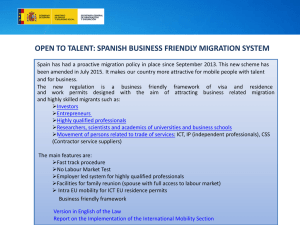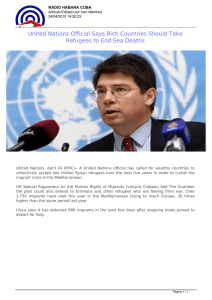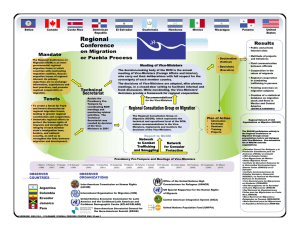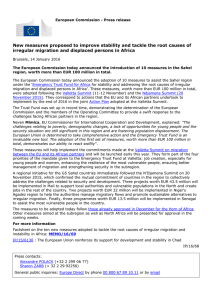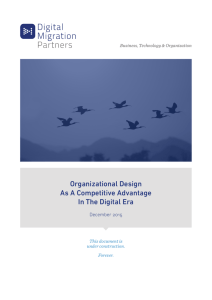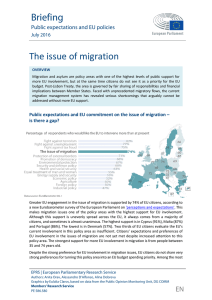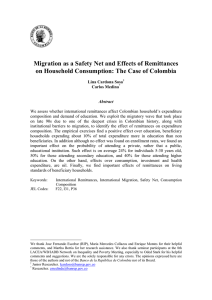and children
Anuncio
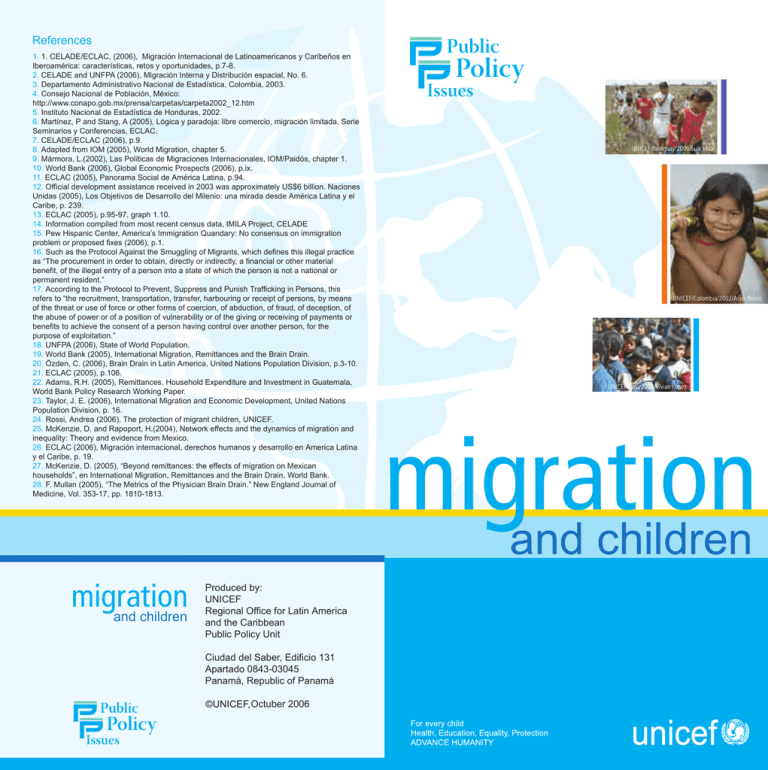
References 1. 1. CELADE/ECLAC, (2006), Migración Internacional de Latinoamericanos y Caribeños en Iberoamérica: características, retos y oportunidades, p.7-8. 2. CELADE and UNFPA (2006), Migración Interna y Distribución espacial, No. 6. 3. Departamento Administrativo Nacional de Estadística, Colombia, 2003. 4. Consejo Nacional de Población, México: http://www.conapo.gob.mx/prensa/carpetas/carpeta2002_12.htm 5. Instituto Nacional de Estadística de Honduras, 2002. 6. Martínez, P and Stang, A (2005), Lógica y paradoja: libre comercio, migración limitada, Serie Seminarios y Conferencias, ECLAC. 7. CELADE/ECLAC (2006), p.9. 8. Adapted from IOM (2005), World Migration, chapter 5. 9. Mármora, L.(2002), Las Políticas de Migraciones Internacionales, IOM/Paidós, chapter 1. 10. World Bank (2006), Global Economic Prospects (2006), p.ix. 11. ECLAC (2005), Panorama Social de América Latina, p.94. 12. Official development assistance received in 2003 was approximately US$6 billion. Naciones Unidas (2005), Los Objetivos de Desarrollo del Milenio: una mirada desde América Latina y el Caribe, p. 239. 13. ECLAC (2005), p.95-97, graph 1.10. 14. Information compiled from most recent census data, IMILA Project, CELADE 15. Pew Hispanic Center, America’s Immigration Quandary: No consensus on immigration problem or proposed fixes (2006), p.1. 16. Such as the Protocol Against the Smuggling of Migrants, which defines this illegal practice as “The procurement in order to obtain, directly or indirectly, a financial or other material benefit, of the illegal entry of a person into a state of which the person is not a national or permanent resident.” 17. According to the Protocol to Prevent, Suppress and Punish Trafficking in Persons, this refers to “the recruitment, transportation, transfer, harbouring or receipt of persons, by means of the threat or use of force or other forms of coercion, of abduction, of fraud, of deception, of the abuse of power or of a position of vulnerability or of the giving or receiving of payments or benefits to achieve the consent of a person having control over another person, for the purpose of exploitation.” 18. UNFPA (2006), State of World Population. 19. World Bank (2005), International Migration, Remittances and the Brain Drain. 20. Özden, C. (2006), Brain Drain in Latin America, United Nations Population Division, p.3-10. 21. ECLAC (2005), p.106. 22. Adams, R.H. (2005), Remittances, Household Expenditure and Investment in Guatemala, World Bank Policy Research Working Paper. 23. Taylor, J. E. (2006), International Migration and Economic Development, United Nations Population Division, p. 16. 24. Rossi, Andrea (2006), The protection of migrant children, UNICEF. 25. McKenzie, D. and Rapoport, H.(2004), Network effects and the dynamics of migration and inequality: Theory and evidence from Mexico. 26. ECLAC (2006), Migración internacional, derechos humanos y desarrollo en America Latina y el Caribe, p. 19. 27. McKenzie, D. (2005), “Beyond remittances: the effects of migration on Mexican households”, en International Migration, Remittances and the Brain Drain, World Bank. 28. F. Mullan (2005), “The Metrics of the Physician Brain Drain.” New England Journal of Medicine, Vol. 353-17, pp. 1810-1813. MIGRATION and children Produced by: UNICEF Regional Office for Latin America and the Caribbean Public Policy Unit Ciudad del Saber, Edificio 131 Apartado 0843-03045 Panamá, Republic of Panamá Octuber 2006 5.)#%&0ARAGUAY,UIS6ERA 5.)#%&#OLOMBIA!SIER2EINO 5.)#%&0ERÞ6IVIAN,OPEZ MIGRATION and children 1 The promises of migration Migration is a growing phenomenon in Latin America and the Caribbean, fuelled by persistent inequalities, lack of opportunities, and social tensions. An increasing number of people are migrating, whether from the countryside to the cities or from their countries of origin to more developed countries, with the hope of improving their standard of living and finding better opportunities for human development. 5.)#%&(1!UDREY-ILLAR Several factors can explain the recent growth in international migration. On one hand, aging populations and low fertility rate in developed countries create a steady supply of jobs with wages up to five times higher than in developing countries. On the other hand, falling transportation and communication costs, as well as the presence of social networks and migrant enclaves throughout destination countries, help facilitate international migration. The benefits associated with cash remittances that migrants send to their families and communities in countries of origin undoubtedly create a powerful motive behind the decision to migrate. Nevertheless, migration is also a clear indicator of the fact that the rights and needs of thousands of people are not being met, prompting them to leave their home countries. Family breakdown and human capital flight, with their implications on the lives of children and adolescents, represent the other face of migration. How can the opportunities offered by migration best be harnessed while reducing the associated risks? There are an estimated 190 million international migrants around the world, 25 million (13%) are from Latin America and the Caribbean. 2 Migration and remittances in Latin America and the Caribbean In recent years, Latin America and the Caribbean have registered a significant increase in emigration. There are an estimated 190 million international migrants around the world, 25 million (13%) are from Latin American and the Caribbean.1 Migration by destinations Migration in Latin America and the Caribbean can be classified into three major categories according to the destination of the migrants: • Internal migration: Following decades of migration from rural areas to the cities, 75% of the population of Latin America and the Caribbean live in urban areas. In recent years, however, migration between urban centres has emerged as the main internal migratory flow in the region.2 There are a considerable number of internal migrants in the region’s countries (8.5 million in Colombia3, 6.8 million in Mexico4, 1.2 million in Honduras).5 • Intra-regional migration: It is estimated that approximately 3 million residents of Latin America and the Caribbean have migrated to other countries within the region. The majority of intra-regional migrants relocate to bordering or nearby countries, with Argentina, Venezuela and Costa Rica being the main destinations.6 • International migration: The vast majority of international migrants from the region can be found in the United States, where 18 million people from Latin America and the Caribbean currently live (in addition to their US-born descendants). Spain is the second most popular destination for extra-regional migration and in 2004 registered 1.2 million immigrants from Latin America and the Caribbean. 7 (ISTORYOFMIGRATIONIN,ATIN !MERICAANDTHE#ARIBBEAN8 %ARLYTH #ENTURY ,ATIN!MERICAANDTHE#ARIBBEANISTHEDESTINATIONOF MILLIONSOFIMMIGRANTSFROMALLOVERTHEWORLDPARTICULARLY 3PAIN)TALY0ORTUGALAND*APAN #ONSIDERABLEINTRAREGIONALMIGRATIONTAKESPLACE)N #ENTRAL!MERICAPOLITICALVIOLENCEIN.ICARAGUAAND%L 3ALVADORRESULTSINLARGESCALEMIGRATIONTOWARDS#OSTA 2ICA)NTHE3OUTHERN#ONETHOUSANDSOFPEOPLEAREFORCED TOFLEEFROMTHEIRCOUNTRIESFORPOLITICALREASONSDURINGTHE MILITARYDICTATORSHIPS !SERIESOFECONOMICPOLITICALANDSOCIALTRENDSFUEL EXTRAREGIONALMIGRATION"ETWEENAND,ATIN !MERICAANDTHE#ARIBBEANBECOMESTHEREGIONWITHTHE WORLDSHIGHESTNETEMIGRATIONRATEDUETOECONOMIC SLOWDOWNUNEMPLOYMENTANDPOLITICALINSTABILITY 0RESENT )NTERNATIONALMIGRATIONCONTINUESTOINCREASEWITH APPROXIMATELYMILLIONPEOPLEFROM,ATIN!MERICAN ANDTHE#ARIBBEANLIVINGABROAD2EMITTANCESATTAIN GREATERIMPORTANCEASTHEMAINSOURCEOFEXTERNAL FINANCINGINTHEREGION Main reasons for migrating People who migrate pursue different objectives and decide to leave their countries for a variety of reasons. Political and economic factors are often the main reasons behind the decision to migrate:9 Political migrants: People who find themselves forced to abandon their countries for political reasons, violence, foreign aggression, internal conflicts, massive human rights violations and other threats fall under this category. Political migrants include refugees, exiles and others. Internally Displaced people are those in similar situations who have been forced to migrate within their countries. In both cases, the principal characteristic is the urgent and forced nature of the migration. Economic migrants: Economic migrants leave their home countries in search of better work opportunities and increased income. On the one hand, unemployed or under-employed people, excluded from formal labour markets and frequently living in poverty, leave their countries in search of better opportunities. Upon arriving to the destination country, they generally work in the informal sector or other precarious spheres of the economy. The vast majority of migrants in Latin America and the Caribbean belong to this group. On the other hand, highly qualified professionals and skilled workers also migrate. Their high educational levels allow them to move within transnational markets which tend to grow over time as regional and global integration increases. Highly skilled migrants constitute a minority within overall migratory flows and tend to leave their countries of origin in search of employment that better corresponds to their academic level. • The flow of remittances into the region has doubled over the course of the present decade. • In 2004, remittances in the region represented a greater source of external financing than foreign investment and official development assistance.12 • The main recipient country in absolute terms is Mexico with close to US$17 billion (2.5% of GDP). However, remittances represent a greater relative importance for countries such as Haiti (29% of GDP), Nicaragua (18%), Guyana (17%), Jamaica (17%) and El Salvador (16%).13 5.)#%&0ANAMÉ#ÏSAR6ILLAR )NTERNATIONALMIGRATIONFROM ,ATIN!MERICAANDTHE#ARIBBEAN #ANADA 5NITED3TATES 5.)#%&$ON"ARLETTI %UROPE *APAN 0ERCENTAGEOFNATIONAL POPULATIONRESIDING ABROAD14 MORETHAN 4HOUSANDS Unlike the free circulation of goods and ideas, migrants face strong restrictions and potential violations of their rights ,ATIN!MERICA ANDTHE#ARIBBEAN )NTERNATIONALMIGRANTS BETWEENAND 7ITHIN THE2EGION )NTHE53! 3OURCE )-),!0ROJECT OF#%,!$%n 0OPULATION $IVISION%#,!# ESTIMATED 9EARS Remittances • Once settled in their destination countries, it has become increasingly common for migrants to send a part of their income to family and friends in their countries of origin. The development of financial networks that facilitate these transfers as well as the overall growth in the number of migrants and in their incomes have in recent years contributed to a significant increase in remittances. Remittances have doubled over the last five years, reaching US$167 billion in 2005, and it is estimated that unregistered remittances could represent as much as 50% more.10 • Latin America and the Caribbean is one of the main remittance-receiving regions, with US$45 billion received in 2004. This figure represents a 30% share of worldwide remittance flows.11 LESSTHAN 4HISMAPDOESNOTREFLECT APOSITIONBY5.)#%&ON THELEGALSTATUSOFANY COUNTRYORTERRITORYOR THEDELIMITATIONOFANY FRONTIERS 3 4HERISKSOF INTERNATIONALMIGRATION The continuous increase in migration flows indicates that many immigrants are achieving the improved economic conditions and higher standards of living they were seeking. Unlike the free circulation of goods and ideas, however, migrants face strong restrictions and potential violations of their rights. The following are a few worrying trends: Irregular migration In a context marked by a lack of social and economic opportunities in countries of origin, the demand for labour in destination countries, and persistent barriers to legal migration, irregular migration has registered a sustained increase. It is estimated that somewhere between 11.5 and 12 million irregular immigrants are living in the United States. Of these, 56% are from Mexico and 22% migrated from other Latin American countries.15 People who migrate irregularly expose themselves to conditions that are harmful to their health and safety. Once settled in the destination country, undocumented migrants cannot exercise their rights and become vulnerable to different types of exploitation. UNICEF/Argentina/2005/Alberto Dario Ginni/Fundación Walter Benjamin Smuggling and human trafficking Despite the existence of international norms that condemn smuggling of migrants16 and human trafficking,17 both practices are frequent in areas experiencing high rates of migration. Smuggling implies a variety of risks to health and lives of migrants and is recognized as a crime in many countries. Trafficking in persons, which affects a large number of children, adolescents and women, is an abominable human rights violation and exposes victims to commercial sexual exploitation and forced labour. Despite the difficulty of making reliable estimates, the US Department of State estimates that each year there are between 600,000 and 800,000 victims of human trafficking worldwide, of whom 80% are women and 50% are children. It is estimated that human trafficking generates between 7-12 billion dollars annually at global level.18 Brain drain Current migration regulations favour the circulation of highly skilled individuals. The consequence for the region’s countries is a continuous loss of professionals and academics. This phenomenon is especially dramatic in certain Caribbean countries, where more than 80% of the highly educated population migrates abroad.19 A related phenomenon is “brain waste,” which takes place when educated migrants from Latin America and the Caribbean face considerable difficulties in finding employment that corresponds to their academic level.20 4 The impact of remittances on human development Remittances constitute an increasingly important source of external financing in Latin America and the Caribbean, with a growing economic and social impact at the national, community and family levels. The percentage of households that receive remittances varies from between 3% (Peru, Bolivia) to close to 20% (Dominican Republic, Nicaragua) of the population. In this context, it is worth asking what the implications of remittances are for human development in the countries of the region. Poverty reduction Only a small portion of households in Latin America and the Caribbean receive remittances. The effect of remittances on overall poverty reduction is therefore relatively low, according to an ECLAC study of eleven countries in the region. Overall, remittances only contribute to reducing poverty by 1.4% and extreme poverty by 1.5%. However, due to their relatively high value, remittances have a drastic effect on the households that do receive them: in 9 out of 11 countries, half of the people living in remittance-receiving households manage to escape poverty and extreme poverty thanks to these transfers. In Nicaragua, it is estimated that 75% of the people in recipient households remain out of poverty and 50% out of extreme poverty as a result of money being sent from abroad.21 Consumption versus family investment According to available data, recipient households use remittances mainly to cover daily consumption needs such as food and housing. This implies a limited margin for investment or savings. In some cases, remittances can facilitate the diversification of family income and allow recipient families to cover the costs of education and other services that involve investment in human capital (see Graph 3). According to a study in Guatemala, families that receive remittances invest up to 15% more in housing and up to 58% more in education than those who do not receive them.22 Promoting public investment Beyond the transfers that each family may receive individually, the productive use of remittances is facilitated when recipient families organize themselves. This is the case with associations that support public investment in recipient localities. One of the most well-known initiatives of this type is the Tres por Uno programme (Three for One) in Mexico. For every dollar sent by migrant associations, the Federal, State and Municipal governments each contribute an additional dollar. Through this mechanism, more than 400 projects have been financed to improve social infrastructure in various municipalities across the country.23 'RAPH ,!4).!-%2)#!COUNTRIES 5SEOFREMITTANCESINRECIPIENTHOUSEHOLDS 'RAPH ,ATIN!MERICAANDTHE#ARIBBEAN -AINSOURCESOFEXTERNALFINANCINGASPERCENTAGEOF'$0 $AILY%XPENSES RENTFOODBILLS "USINESSINVESTMENTS /$! &$) 2EMITTANCES $EBT 3OURCE5NITED.ATIONS 4HE-ILLENNIUM$EVELOPMENT 'OALS!,ATIN!MERICANAND #ARIBBEAN0ERSPECTIVEP 0ERCENTAGE 3AVINGS 0ROPERTY0URCHASES (OUSING %DUCATION /THER#ATEGORIES 3OURCE'RAPHCONSTRUCTEDFROM %#,!#DATA3OCIAL0ANORAMA OF,ATIN!MERICA -ÏXICO (ONDURAS 'UATEMALA %L3ALVADOR %CUADOR 2EP$OM "RAZIL #OLOMBIA "OLIVIA Migration and remittances have several consequences for children and adolescents, although their full implications are yet to be analyzed in detail.24 Greater opportunities for development Whether they are accompanying their parents, migrating in order to reunite with their families, or receiving financial assistance sent from abroad, children and adolescents can benefit from greater development opportunities as a result of migration. Remittances provide financial assistance to families and help them reach an adequate standard of living for their children that might not otherwise be 5.)#%&"ELICE#ESAR6ILLAR attainable. Remittances can contribute to providing food, housing, better health and education as well as reducing child labour. According to a study of Mexican households, remittances help improve the medical conditions of infants, reducing post-partum malnutrition by 5.4%, infant mortality by 3% and increasing the probability of professional assistance to childbirth by 30%. 25 Less protection in the absence of parents While remittances can financially contribute to child development in certain aspects, the absence of parents effectively increases the probability that children will not receive adequate care and protection. In many cases, if one or both parents migrate, household and family responsibilities are taken up by older adults, extended family members, or even siblings. In any of these cases, there is a real or potential risk that children will not receive the same healthcare, nutrition and protection against abuse and exploitation that they would receive if their parents were present. The absence of mothers restricts the duration of breastfeeding and in some cases lowers the probability that children will receive their immunizations in a timely and appropriate manner. Family disintegration Separation from parents, grandparents and other close family members has consequences that go beyond healthcare and physical development for children who are left behind by migrants or who must themselves migrate. Their absence implies the loss of important role models, which can have a significant psycho-social impact often leading to feelings of abandonment, vulnerability and loss of self-esteem. In certain cases, adolescents and older children assume responsibility for the care of siblings in the absence of their parents. This can lead to an untimely process of maturation caused by undertaking responsibilities that correspond to adulthood and increases the probability of abandoning school. UNICEF/HQ95-0471/ David Barbour 5 The consequences for children Lack of documentation The high rate of irregular migration implies that many migrants and their families are undocumented in their destination countries. Between 1986 and 2002, the number of undocumented 5.)#%&$AN"ARLETTI migrants in the United States tripled (from 3.2 million to 9.3 million). Almost half of the immigrants from Latin America and the Caribbean residing in the United States are undocumented.26 Living as undocumented immigrants violates the rights of children to a name and a nationality. Moreover, it inhibits their access to healthcare and education services and makes them especially vulnerable to trafficking, illegal adoption and commercial sexual exploitation. Educational opportunites and challenges Remittances are an important form of financial support for education, preventing children from dropping out and becoming involved in child labour. In the case of migrant children, the destination countries can offer new educational opportunities but may also lead to difficulties adapting to a new curriculum and in many cases a new language. On the other hand, an effect strongly associated with migration and remittances is the growing notion that emigrating constitutes a goal in itself. This can act as a disincentive for the educational efforts of parents and children in their countries of origin. Parents who have the intention to migrate tend to invest less in the education of their children due to the perceived lack of recognition of these efforts in the destination country. For example, girls in Mexican households with migrants receive an average 1.7 years of education less than girls living in households without migrants.27 Lack of qualified personnel Beyond the negative effects on economic and institutional development, the brain drain associated with migration threatens the provision of quality services, especially health and education. For example, children are affected by the lack of medical personnel in a country like Jamaica, where approximately 40% of doctors have emigrated.28 Greater vulnerability to human trafficking Migration, especially in irregular circumstances, considerably increases the vulnerability of children and adolescents to several kinds of exploitation, including prostitution and other forms of sexual exploitation. Children and adolescents in these circumstances are frequently used as a cheap source of labour, exploited in domestic work or given up for illegal adoptions. This has serious consequences for the 5.)#%&%L3ALVADOR#ESAR6ILLAR lives and health of children, above all in connection with various types of violence and abuse. In many cases, trafficked children are doubly victimized when they are repatriated to their countries of origin under an absolute lack of protection. 6 How Can the Positive Effects of Remittances Be Harnessed While Addressing the Risks of Migration? Migration While remittances can financially contribute to child development in certain aspects, the absence of parents increases the probability that children will not receive adequate care and protection. 5.)#%&0ERÞ!LEJANDRO"ALAGUER Reducing irregular migration by moving from migration control towards migration management . • Promote cooperation and coordination in the management of migration policies between bordering countries so as to guarantee respect for the rights of migrants and their families. • Include migration issues in regional and international commercial agreements. • Establish clear and transparent migration procedures that can facilitate monitoring of migratory flows and enhance the prevention of human trafficking and smuggling. • Combat the exploitation of irregular migrant labour, especially children and adolescents, through better supervision of employers and a strengthening of civil and criminal sanctions where relevant. • Promote organized migrant worker programmes for unskilled labourers. Protecting child migrants and their families • Ensure that national legislation provides adequate protection for the rights of migrant children and their families. • In accordance with the Convention on the Rights of the Child, guarantee the right to family reunification for the children of migrant parents. • In accordance with the Convention on the Rights of the Child, guarantee access to basic health and education services to all children, regardless of their legal or migratory status. • Drastically reduce the prevalence of undocumented migrants through efficient and decentralized registration systems. In particular, establish the necessary conditions to guarantee that all children enjoy free and timely birth registration in all countries. • Establish programmes that can inform, support and provide orientation to recent migrants and their families in regions with a high influx of migrants. • Provide training in children’s rights to customs and immigration personnel. • Create and implement rapid response programmes for severe cases of displacement. 5.)#%&0REMIOS)BEROAMERICANOS!RGENTINA 5.)#%&%L3ALVADOR+ARLA2ODRÓGUEZ 5.)#%&0ANAMÉ)SABEL"ENLLOCH 5.)#%&0ARAGUAY,UIS6ERA • Combat human trafficking and smuggling by strengthening the prosecution of people involved in these crimes, creating information and education campaigns, and establishing international agreements to protect victims. Addressing the brain drain • Facilitate the return of migrants by promoting dual nationality and the transferability of social security and pension systems. • Strengthen academic ties and promote temporary visits so as to involve migrants in the development of their countries of origin. Remittances • Promote the use of remittances in community investment through municipal governments and migrant associations. • Facilitate poor people’s access to formal financial institutions, credit cooperatives and micro-credit institutions. • Design and implement policies designed to favour the productive use of remittances so as to enhance their effects on the reduction of poverty and social inequality. • Reduce the costs involved in sending remittances. The transfer mechanisms most widely used by migrants have relatively high transaction costs, thus reducing the amount of money being received by their families. Greater competition should be promoted through the integration of commercial distribution chains, postal offices and bank networks into the remittance services market. In the short term, it is necessary to improve migration policies and mechanisms in order to effectively protect the rights of migrants and their families. However, a more sustainable approach must address the underlying social and economic inequalities that force people to migrate in search of better opportunities. Every individual must have the conditions necessary for full human development in his/her own country of origin.
